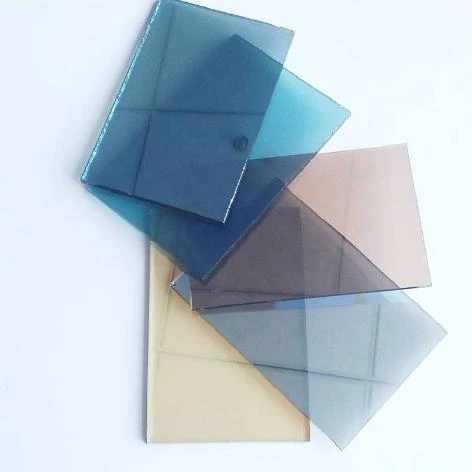The Float Glass Manufacturing Process
Float glass, also known as flat glass, is one of the most common types of glass used in construction, automotive, and various industrial applications. The manufacturing process of float glass is a remarkable interplay of science and engineering, resulting in a product that is both aesthetically pleasing and performance-oriented. This article delves into the intricacies of the float glass manufacturing process, highlighting its key stages and innovations.
The float glass manufacturing process begins with the careful selection of raw materials
. The primary ingredients include silica sand, soda ash, and limestone, which are combined in a furnace at high temperatures exceeding 1,600 degrees Celsius (about 2,912 degrees Fahrenheit). Other materials, such as alumina, magnesium oxide, and various additives, may be included to enhance specific properties of the final glass product.
Once the raw materials are thoroughly mixed and melted, the molten glass is poured onto a surface of molten tin in a controlled environment. This step is crucial, as the tin acts as a medium that enables the glass to float and form a perfectly flat surface without the formation of bubbles or irregularities. The genius of the float glass method lies in the chemistry of the materials and the physics of fluid dynamics. The molten glass spreads out, forming a continuous ribbon of glass that is uniform in thickness.
float glass manufacturing process
As the glass ribbon moves along the float line, it undergoes a cooling process known as annealing. It is passed through a series of controlled heating and cooling zones in a lehr (a type of oven) to relieve internal stresses. This step is vital to ensure the durability and strength of the glass. The thickness of the glass can be controlled by adjusting the speed at which it moves along the float line.
After the cooling process, the continuous ribbon of glass is cut into sheets of desired dimensions. The cut sheets then go through a quality control process where they are inspected for defects, such as bubbles, waves, or scratches. Any subpar glass is discarded to maintain high standards.
In recent years, advancements in technology have optimized the float glass manufacturing process. Automation and computerized systems improve precision and reduce human error. Environmentally friendly practices, such as recycling cullet (recycled glass), are increasingly integrated into the process, reducing waste and energy consumption.
In conclusion, the float glass manufacturing process is a sophisticated blend of high-temperature technology, material science, and engineering precision. The ability to produce large sheets of flat glass with consistent quality and minimal defects has revolutionized the glass industry. As technology continues to evolve, the float glass process will undoubtedly become even more efficient, sustainable, and innovative.
 Afrikaans
Afrikaans  Albanian
Albanian  Amharic
Amharic  Arabic
Arabic  Armenian
Armenian  Azerbaijani
Azerbaijani  Basque
Basque  Belarusian
Belarusian  Bengali
Bengali  Bosnian
Bosnian  Bulgarian
Bulgarian  Catalan
Catalan  Cebuano
Cebuano  Corsican
Corsican  Croatian
Croatian  Czech
Czech  Danish
Danish  Dutch
Dutch  English
English  Esperanto
Esperanto  Estonian
Estonian  Finnish
Finnish  French
French  Frisian
Frisian  Galician
Galician  Georgian
Georgian  German
German  Greek
Greek  Gujarati
Gujarati  Haitian Creole
Haitian Creole  hausa
hausa  hawaiian
hawaiian  Hebrew
Hebrew  Hindi
Hindi  Miao
Miao  Hungarian
Hungarian  Icelandic
Icelandic  igbo
igbo  Indonesian
Indonesian  irish
irish  Italian
Italian  Japanese
Japanese  Javanese
Javanese  Kannada
Kannada  kazakh
kazakh  Khmer
Khmer  Rwandese
Rwandese  Korean
Korean  Kurdish
Kurdish  Kyrgyz
Kyrgyz  Lao
Lao  Latin
Latin  Latvian
Latvian  Lithuanian
Lithuanian  Luxembourgish
Luxembourgish  Macedonian
Macedonian  Malgashi
Malgashi  Malay
Malay  Malayalam
Malayalam  Maltese
Maltese  Maori
Maori  Marathi
Marathi  Mongolian
Mongolian  Myanmar
Myanmar  Nepali
Nepali  Norwegian
Norwegian  Norwegian
Norwegian  Occitan
Occitan  Pashto
Pashto  Persian
Persian  Polish
Polish  Portuguese
Portuguese  Punjabi
Punjabi  Romanian
Romanian  Russian
Russian  Samoan
Samoan  Scottish Gaelic
Scottish Gaelic  Serbian
Serbian  Sesotho
Sesotho  Shona
Shona  Sindhi
Sindhi  Sinhala
Sinhala  Slovak
Slovak  Slovenian
Slovenian  Somali
Somali  Spanish
Spanish  Sundanese
Sundanese  Swahili
Swahili  Swedish
Swedish  Tagalog
Tagalog  Tajik
Tajik  Tamil
Tamil  Tatar
Tatar  Telugu
Telugu  Thai
Thai  Turkish
Turkish  Turkmen
Turkmen  Ukrainian
Ukrainian  Urdu
Urdu  Uighur
Uighur  Uzbek
Uzbek  Vietnamese
Vietnamese  Welsh
Welsh  Bantu
Bantu  Yiddish
Yiddish  Yoruba
Yoruba  Zulu
Zulu 

